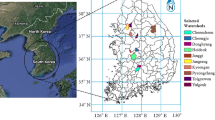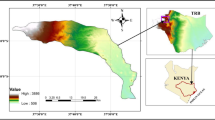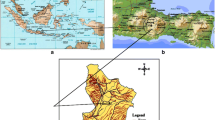Abstract
Dry tropical forests account for over 1,000,000 km2, and there is still lack of knowledge on their hydrologic processes. The curve number (CN) hydrologic model developed by the Natural Resources Conservation Service (NRCS) is widely applied for runoff determination in various parts of the world, but not so in tropical semiarid regions. This study analyzes the impact of land use changes on the CN model in a tropical semiarid environment, in two catchments of native dry tropical forest and thinned dry tropical forest land use from 2009 to 2012. The CN model was calibrated and validated for the NRCS recommended initial abstraction ratio λ = 0.2, and for λ evaluated from rainfall and runoff data. A reliability analysis was performed using Monte Carlo simulation. Model goodness-of-fit was assessed with statistical criteria. A total of 42 and 40 rainfall-runoff events were analyzed for the native and thinned dry tropical forest, respectively. Characteristic λ values of 0.15 and 0.11 were determined for the two respective catchments. Although CN values were similar for both land uses, CNλ=0.20 = 80 and CNmedian λ = 77, the thinned catchment showed a higher CN model parameters variability. The CN model was more sensitive to variations of CN values than to those of λ. This study showed that no matter the vegetation management in a dry tropical forest environment, modeled runoff is not affected by λ, but rather affected by CN, which represents soil, landuse and management.








Similar content being viewed by others
References
Andrade EM, Palácio HAQ, Santos JCN, Guerreiro MJS, Rodrigues JA (2012) Runoff curve number for a small forested watershed in a semiarid region of Brazil. In: 21st century watershed technology: improving water quality and the environment conference proceedings, may 27-June 1, 2012, Bari, Italy 12-13705. doi:10.13031/2013.41406
Araújo JC, Piedra JIG (2009) Comparative hydrology: analysis of a semiarid and a humid tropical watershed. Hydrol Process 23(8):1169–1178. doi:10.1002/hyp.7232
Baltas EA, Dervos NA, Mimikou MA (2007) Technical note: determination of the SCS initial abstraction ratio in an experimental watershed in Greece. Hydrol Earth Syst Sci 11(6):1825–1829. doi:10.5194/hess-11-1825-2007
Banasik K, Woodward D (2010) Empirical determination of runoff curve number for a small agricultural watershed in Poland. 2nd joint Federal Interagency Conference, Las Vegas, NV, June 27 - July 1
Beven K (2012) Rainfall-runoff modelling: the primer, 2nd edn. John Wiley & Sons, Ltd, Chichester. doi:10.1002/9781119951001.refs
Cao H, Vervoort RW, Dabney SM (2011) Variation in curve numbers derived from plot runoff data for new South Wales (Australia). Hydrol Process 25:3774–3789
EMBRAPA (2006) Sistema brasileiro de classificação de solos, 2nd edn. CNPS EMBRAPA, Rio de Janeiro, 2006. 306 p
Farrick KK, Branfireun BA (2013) Left high and dry: a call action for increased hydrological research in dry tropical forests. Hydrol Process 27:3254–3253. doi:10.1002/hyp.9935
Figueiredo JV (2011) Início da geração do escoamento superficial em uma bacia semiárida em Caatinga preservada. Dissertação (Mestrado em Engenharia Agrícola). Universidade Federal do Ceará, Fortaleza, Ceará, Brasil
Hawkins RH, Jiang R, Woodward DE, Hjelmfelt AT, Van Mullem JA, Quan QD (2002) Runoff curve number method: examination of the initial abstraction ratio, in proceedings of the second Federal Interagency. Hydrologic Modeling Conference, ASCE Publications: Las Vegas, Nevada, doi:10.1061/40685(2003)308
Herrera-Pantoja M, Hiscock KM (2015) Projected impacts of climate change on water availability indicators in a semi-arid region of central Mexico. Environ Sci pol 54:81–89
Lanckriet S, Araya T, Cornelis W, Verfaillie E, Poesen J, Govaerts B, Bauer H, Deckers J, Haile M, Nyssen J (2012) Impact of conservation agriculture on catchment runoff and soil loss under changing climate conditions in may Zeg-zeg (Ethiopia). J Hydrol 475:336–349. doi:10.1016/j.hydrol.2012.10.011
Mccuen RH, Snyder WM (1986) Hydrologic modelling: statistical methods and applications. Prentice Hall, Englewood Cliffs, 568pp
Michaellides S, Levizzani V, Anagnostou E, Bauer P, Kasparis T, Lane JE (2009) Rainfall: measurement, remote sensing, climatology and modeling. Atmos res 94(4):512–533. doi:10.1016/j.atmosres.2009.08.0l7
Miles L, Newton AC, DeFries RS, Ravilious C, May I, Blyth S, Kapos V, Gordon JE (2006) A global overview of the conservation status of dry tropical forests. J Biogeogr 33(3):491–505. doi:10.1111/j.1365-2699.2005.01424.X
Mishra SK, Singh VP (2004) Long-term hydrological simulation based on the soil conservation service curve number. Hydrol Process 18(7):1291–1313. doi:10.1002/hyp.1344
Nearing MA, Deer-Ascough L, Laflen JM (1990) Sensitivity analysis of the WEPP hillslope profile erosion model. Transactions of the ASAE 33(3):839–849
Ponce VM, Hawkins RH (1996) Runoff curve number: has it reached maturity? J Hydrol Eng 1(1):11–19
Rodrigues JO, Andrade EM, Mendonça LAR, Palacio HAQ, Araujo JC, Araújo EM (2013) Respostas hidrológicas em pequenas microbacias na região semiárida em função do uso do solo. Rev Bras Eng Agric Ambient 17(3):312–318. doi:10.1590/S1415-43662013000300007
Sahu RK, Mishra SK, Eldho TI (2010) Comparative evaluation of SCS-CN inspired models in applications to classified datasets. Agr Water Manage 97(5):749–756. doi:10.1016/j.agwat.2010.01.005
Santos JC, Leal IR, Almeida-Cortez JS, Fernandes GW, Tabarelli M (2011) Caatinga: the scientific negligence experienced by a dry tropical forest. Tropical Conservation Science 4(3):276–286
SCS (Soil Conservation Service) (1972) SCS National Engineering Handbook, Section 4. Hydrology, Soil Conservation Service. US Department of Agriculture, Washington, DC
Shi ZH, Chen LD, Fang NF, Qin DF, Cai CF (2009) Research on the SCS-CN initial abstraction ratio using rainfall-runoff event analysis in the three gorges area, China. Catena 77:1–7. doi:10.1016/j.catena.2008.11.006
Singh PK, Mishra SK, Berndtsson R, Jain MK, Pandey RP (2015) Development of a modified SMA based MSCS-CN model for runoff estimation. Water Resour Manag 29:4111–4127. doi:10.1007/s11269-015-1048-1
Taguas EV, Gómez JÁ, Denisi P, Mateos L (2015) Modelling the rainfall-runoff relationships in a large olive orchard catchment in southern Spain. Water Resour Manag 29:2361–2375. doi:10.1007/s11269-015-0946-6
Tyagi JV, Mishra SK, Singh R, Singh VP (2008) SCS-CN based time-distributed sediment yield model. J Hydrol 352:388– 403. doi:10.1016/j.hydrol.2008.01.025.
USDA (1986). Urban hydrology for small watersheds. Technical release 55: 164 pp, Washington, DC
Woodward DE, Hawkins RH, Jiang R, Hjelmfelt AT, Van Mullem JA, Quan QD (2003) Runoff curve number method: examination of the initial abstraction ratio. Proceedings of the Second Federal Interagency Hydrologic Modeling Conference, Las Vegas, Nevada.U.S. Geological Survey, Lakewood, Colorado. CD-ROM. 2002. doi:10.1061/40685(2003)308
Xiao B, Wang Q, Fan J, Han F, Dai Q (2011) Application of the SCS-CN model to runoff estimation in a small watershed with high spatial heterogeneity. Pedosphere 21(6):738–749. doi:10.1016/S1002-0160(11)60177-X
Yuan Y, Nie W, McCutcheon SC, Taguas EV (2014) Initial abstraction and curve numbers for semiarid watersheds in southeastern Arizona. Hydrol Process 28:774–783. doi:10.1002/hyp.9592
Acknowledgements
The authors wish to thank Brazilian National Council for Scientific and Technological Development (CNPq) for their financial support of this research.
Author information
Authors and Affiliations
Corresponding author
Electronic supplementary material
Online Resource 1
(PDF 288 kb)
Online Resource 2
(PDF 284 kb)
Rights and permissions
About this article
Cite this article
Andrade, E.M., Araújo Neto, J.R., Guerreiro, M.J.S. et al. Land Use Effect on the CN Model Parameters in a Tropical Dry Environment. Water Resour Manage 31, 4103–4116 (2017). https://doi.org/10.1007/s11269-017-1732-4
Received:
Accepted:
Published:
Issue Date:
DOI: https://doi.org/10.1007/s11269-017-1732-4




